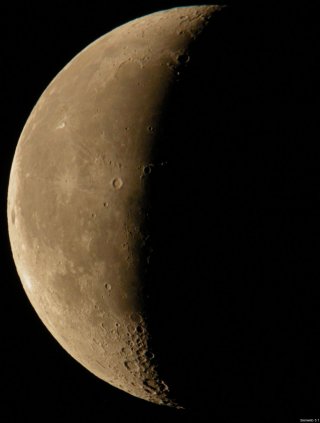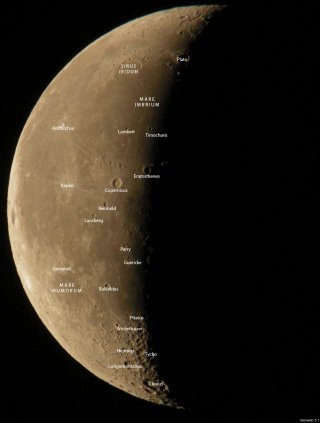After several days in a row of getting up between 2 and 4 a.m. to get the moon as close to zenith as possible, I’m getting used to waking up at that hour. And that, ironically, makes it harder to get shots of the moon between last quarter and new, as it is now (Day 23 of the lunation). This morning my eyes flew open at 4:19 a.m. and, rather than risk going back to bed and sleeping through the better, later hour when the moon would be higher in the sky, I went outside and took a few shots.
The lower the moon is, the harder it is to get the exposure settings right; the fairly simple point and shoot exercise I’ve been indulging in over the last couple of weeks is gone. Every night until last night (that is, Day 22 and then this morning, Day 23) I had the camera set at ISO 64 (the slowest setting on the camera). This reduces the noise in the image as much as possible, so I can get the sharpest and clearest details. This morning, though, with the moon low in the sky (only 23° above the horizon!) and only 0.36 illuminated, I had to bump the ISO up all the way to 400 to get a decent exposure, even at the relatively slow shutter speed of of 1/30 sec. The slow shutter speed and the high ISO means that the image is noisier, which makes it look grainier.
But the resulting images were still good enough to have some fun with; this is the first time I’ve ever seen this phase of the moon, and it’s interesting getting acquainted with some old friends when the sun is coming at them from the sunset, rather than the sunrise, side.
Plato, in particular, looks dramatically different from any time I’ve ever seen it before. The center is entirely dark, with only the innermost edges of the eastern rim wall being lit up by the sun. I’m used to seeing this crater with the floor completely lit, playing the “count-the-craterlets” game. (I’d have to check my observing log for some years back, but I don’t think I’ve ever seen 5; seeing 4 (even 3) means you’ve got a pretty steady night that allows some good magnification, and most probably at least a 5″ scope. Not a single image of any of these over the past month has shown even one; a 60-mm scope with a point-and-shoot camera just can’t overcome the technical limitations. I might try adapting a webcam at some point and seeing if I can’t do better…)
Proceeding southward through the Mare Imbrium from Plato, we come to Timocharis and then Eratosthenes, both of which are illuminated similarly to Plato: dark floor, sunlit rim walls. Timocharis is slightly west of the sunset line, but Eratosthenes, like Plato, is right on the line.
Moving south from there, we come to the Mare Insularum, site of the Apollo 12 and 14 landings, with the submerged craters Parry and Guericke right near the sunset line; if you look closely you can make out Fra Mauro, a larger, even more submerged crater, just above and to the left of Parry.
Skipping over a few prominent craters, now, we come to the giant southern crater, Clavius, lit most dramatically right now, with the floor still in sunshine, but the two craters that impinge upon it in the east, Porter and Rutherfurd, in shadow.
I’m going to have to try to “sleep in” tomorrow morning. I’ll have to find that fine balance between letting the moon rise high enough to be visible and getting out early enough that I’m not shirking my duties as “morning dad” (morning mom being, in general, a sleeping mom)… The 5:30 a.m. moon will be at 24° elevation; I’ll have to hope that’s good enough. The boy’s almost always up by 6 a.m.



